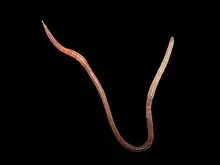| Pontoscolex corethrurus | |
|---|---|
 | |
| Scientific classification | |
| Domain: | Eukaryota |
| Kingdom: | Animalia |
| Phylum: | Annelida |
| Class: | Clitellata |
| Order: | Opisthopora |
| Suborder: | Lumbricina |
| Family: | Glossoscolecidae |
| Genus: | Pontoscolex |
| Species: | P. corethrurus |
| Binomial name | |
| Pontoscolex corethrurus Muller, 1856[1] | |
Pontoscolex corethrurus is an earthworm in the genus Pontoscolex. It has a circumtropical distribution,[2] although it originates in the Neotropics, probably in the Guiana Plateau.[3]
Description
The worms are unpigmented and have around 200 segments.[1] Adults measure 5–10 cm (2.0–3.9 in) in length.[3]
Reproduction
It reproduces both parthenogenetically and (rarely) sexually,[4] and under experimental conditions can complete its life cycle in about one year.[3]
Ecology and habitat
The worm thrives in difficult environments with poor nutrition.[5] It is key to emergence of agriculture in the Amazon Basin, where soil is extremely poor. It may have facilitated the formation of terra preta.[5]
On the other hand, the worm's adaptability has allowed it to spread to many disturbed tropical areas, especially urban sites and industrially-farmed areas.[5] It is now considered an invasive species in many parts of the world.[2][6] An endogeic worm creating globular casts, it is considered responsible for soil compaction in sweet potato fields, in maize fields, and in Amazonian pastures newly converted from forest. This ecosystem engineering also makes it harder for native species to return to their original habitat.[7]
Decontamination
Pontoscolex corethrurus is useful in bioremediation.[8] Studies including Ferreira et al., 2021 find that they combine synergistically with biochar.[8]
See also
References
- 1 2 "Pontoscolex corethrurus (Muller, 1856)". www.gbif.org.
- 1 2 Marichal, Raphael; et al. (2010). "Invasion of Pontoscolex corethrurus (Glossoscolecidae, Oligochaeta) in landscapes of the Amazonian deforestation arc" (PDF). Applied Soil Ecology. 46 (3): 443–449. doi:10.1016/j.apsoil.2010.09.001. S2CID 84810586.
- 1 2 3 Buch, Andressa Cristhy; et al. (2011). "Life cycle of Pontoscolex corethrurus (Müller, 1857) in tropical artificial soil". Pedobiologia. 54: S19–S25. doi:10.1016/j.pedobi.2011.07.007.
- ↑ Dupont, L.; Decaëns, T.; Lapied, E.; Chassany, V.; Marichal, R.; Dubs, F.; Maillot, M.; Roy, V. (November 2012). "Genetic signature of accidental transfer of the peregrine earthworm Pontoscolex corethrurus (Clitellata, Glossoscolecidae) in French Guiana". European Journal of Soil Biology. 53: 70–75. doi:10.1016/j.ejsobi.2012.09.001.
However, Gates [8] observed that copulation may be completed by some individuals, suggesting that biparental reproduction might be possible in P. corethrurus. Such outcrossing events might restore genetic variability in populations.
- 1 2 3 Ortíz-Ceballos, Angel I.; Ortiz-Gamino, Diana; Andrade-Torres, Antonio; Pérez-Rodríguez, Paulino; López-Ortega, Maurilio (20 September 2019). "Pontoscolex corethrurus: A homeless invasive tropical earthworm?". PLOS ONE. 14 (9): e0222337. doi:10.1371/journal.pone.0222337. PMC 6754163. PMID 31539381.
- ↑ "南美種壓境 本土蚯蚓處境艱難" [South American species invades; native earthworms struggle to survive]. 環境資訊中心 (Environmental Information Center, Taiwan) (in Chinese (Taiwan)). August 6, 2013. Retrieved 23 May 2022.
- ↑ Lavelle, Patrick; Barot, Sebastien; Blouin, Manuel; Decaëns, Thibaud; Jimenez, Juan José; Jouquet, Pascal (2007). "5 Earthworms as key actors in self-organized soil systems". Theoretical Ecology Series. Vol. 4. pp. 77–I. doi:10.1016/S1875-306X(07)80007-4. ISBN 9780123738578.
- 1 2
- Hou, Shuyu; Wang, Jue; Dai, Jun; Boussafir, Mohammed; Zhang, Chi (2022). "Combined effects of earthworms and biochar on PAHs-contaminated soil remediation: A review". Soil Ecology Letters (SEL). Springer Science and Business Media LLC. 5 (2). doi:10.1007/s42832-022-0158-y. ISSN 2662-2289. S2CID 255290441.
- This review cites this research.
- Ferreira, Talita; Hansel, Fabricio Augusto; Maia, Claudia M.B.F.; Guiotoku, Marcela; Cunha, Luís; Brown, George G. (2021). "Earthworm-biochar interactions: A laboratory trial using Pontoscolex corethrurus". Science of the Total Environment. Elsevier BV. 777: 146147. doi:10.1016/j.scitotenv.2021.146147. ISSN 0048-9697. S2CID 233850488.